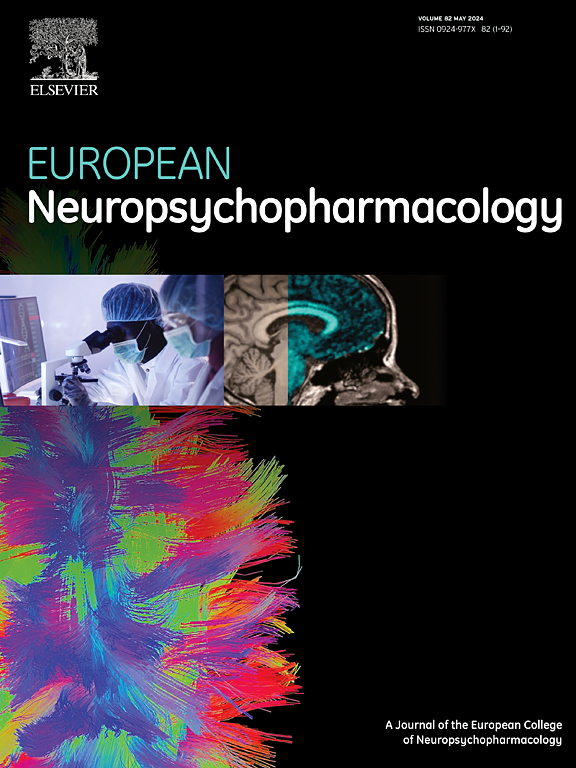墨西哥青少年内化和外化障碍的共同遗传风险:逆境的调节作用
IF 6.7
2区 医学
Q1 CLINICAL NEUROLOGY
引用次数: 0
摘要
内化(INT)和外化(EXT)障碍是经常同时发生的遗传性疾病。大规模全基因组关联研究(GWAS)增强了我们对这些疾病的多基因结构的理解;然而,与他们的合并症相关的遗传因素仍不清楚。在这里,我们利用大规模GWAS对INT和EXT的汇总统计数据(Thorp等人,2021;Karlsson linn本文章由计算机程序翻译,如有差异,请以英文原文为准。
SHARED GENETIC RISK FOR INTERNALIZING AND EXTERNALIZING DISORDERS IN MEXICAN ADOLESCENTS: THE MODERATING EFFECT OF ADVERSITY
Internalizing (INT) and externalizing (EXT) disorders are heritable conditions that frequently co-occur. Large-scale genome-wide association studies (GWAS) have enhanced our understanding of the polygenic architecture of these disorders; yet genetic factors associated with their comorbidity remain unclear. Here, we leverage large-scale GWAS summary statistics on INT and EXT (Thorp et al., 2021; Karlsson Linnér et al., 2021) to examine the association of shared and unique genetic liability for INT and EXT disorders in relation to phenotypic comorbidity, and explored whether childhood adversity, a well-established risk factor for these disorders moderated these associations. Participants were Mexican adolescents (n=1,134 evaluated within the framework of an epidemiological study with the Composite International Diagnostic Interview. Genomic structural equation modeling (gSEM) was used to identify common vs. unique variance associated with INT, EXT, and comorbidity of these traits. Polygenic risk scores (PGS) were subsequently created based on these results. Model fit indices supported a bifactor gSEM model (AIC = 750.978, CFI = 0.973, SRMR = 0.052) comprised of a General Psychopathology (GP) factor influencing all traits and orthogonal specific factors for externalizing and internalizing traits. The GP-PGS was significantly associated with EXT (OR = 1.3, p < 0.001) and comorbid INT-EXT (OR = 1.42, p < 0.000) outcomes. Adversities, such as parental psychopathology and neglect/abuse were associated with greater risk for all psychiatric outcomes (p < 0.001), while Parental Loss (p < 0.001) was specifically associated with EXT disorders (p < 0.000). A significant interaction was identified between GP-PGS and Loss adversity in predicting INT disorders (OR = 1.63, p < 0.016), such that the experience of loss adversity was more influential for participants with higher levels of GP genetic liability. Our results indicate the predictive utility of trans-diagnostic, genetically informed models and the importance of considering specific adversities in understanding psychiatric risk for INT and EXT comorbidity.
求助全文
通过发布文献求助,成功后即可免费获取论文全文。
去求助
来源期刊

European Neuropsychopharmacology
医学-精神病学
CiteScore
10.30
自引率
5.40%
发文量
730
审稿时长
41 days
期刊介绍:
European Neuropsychopharmacology is the official publication of the European College of Neuropsychopharmacology (ECNP). In accordance with the mission of the College, the journal focuses on clinical and basic science contributions that advance our understanding of brain function and human behaviour and enable translation into improved treatments and enhanced public health impact in psychiatry. Recent years have been characterized by exciting advances in basic knowledge and available experimental techniques in neuroscience and genomics. However, clinical translation of these findings has not been as rapid. The journal aims to narrow this gap by promoting findings that are expected to have a major impact on both our understanding of the biological bases of mental disorders and the development and improvement of treatments, ideally paving the way for prevention and recovery.
 求助内容:
求助内容: 应助结果提醒方式:
应助结果提醒方式:


